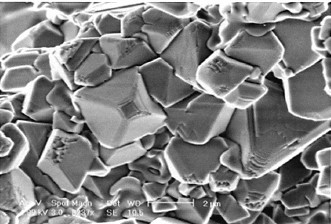Nozzle clogging in stainless steel can be due to thermal clogs or clogs due to agglomeration and precipitation of indigenous inclusions. Although there can be many reason some of the few potential causes of clogging; however, there are three generic issues: thermal problems, either due to heat transfer to the nozzle or low super heat in steel , transport and agglomeration of solid or semi-solid inclusions to a refractory interface, precipitation of solid or semi-solid materials on the refractory surface.
Titanium is typically used as an alloy to stabilize nitrogen with amount of additions going as high as 0.4 wt%. Generally, titanium treated grades are also deoxidized by aluminum to ensure that alumina is the stable oxide while a few being titanium deoxidized. The buildup from these stainless grades is related to the details of the steel chemistry and the rate of heat loss through the nozzle. All that is necessary for clogging is the presence or precipitation of an inclusion that is solid or a thermal gradient responsible for the solidification of the steel.
A precipitation clog can get exacerbated by thermal loss through the SEN leading to higher rate of buildup. As areas of low temperature lead to precipitation of titanium nitride, the thermal condition of the inside of the SEN will also be a key in understanding precipitation of TiN. Analysis of the such clogs shows three dimensional titanium nitride cubes been imbedded in a metal matrix. The titanium nitride forms a complete three-dimensional network with each cube in contact with others for clogs in case of 310 stainless steel grades.
However, clog may even contain both magnesium aluminate spinel and titanium nitride which represents both a precipitation and an agglomeration clog. This can happen for 409 stainless steel grade but its morphology is different to those of the 321 steel with major portion of the clog being TiN, and the rest being magnesium aluminate spinel. The TiN cubes also are coated with or connected by magnesium aluminate spinel which indicates the presence of soluble magnesium in these heats.
Reaction between particles in the solid state can give rise to the formation of an intermediate layer between the spinel particle and the TiN cube. In the interior of the clog, the spinel phase can be found solely at the contact points of the cubes.
In stainless steel clogs where TiN is the clogging material, it is clear that growth of the inclusion is responsible for clogging; however, when the spinel phase is present, a combination of growth and agglomeration can be seen that can result in accelerated buildup.
Summary of Chocked compounds in stainless steel
TiN : A precipitation product during casting of stainless steel grades if the equilibrium condition is violated.
TiN and MgO-Al2O3 (spinel) : Takes place in 400-series stainless steels.
© Metal world insight



